All 8 entries tagged Julius Caesar
No other Warwick Blogs use the tag Julius Caesar on entries | View entries tagged Julius Caesar at Technorati | There are no images tagged Julius Caesar on this blog
August 01, 2019
From divinity to the Duce: the many meanings of the Julian Star
 |
|
Augustus, Caesaraugusta (possibly), Spain, denarius, 19-18 BC.
RIC 1 37b, pg.44 (British Museum, R.6067).
Obverse: CAESAR AVGVSTVS; head of Augustus, wearing oak-wreath, left.
Reverse: DIVVS IVLIVS; comet with eight rays and tail upwards.
|
During Julius Caesar’s memorial games in 44 BC, a great comet allegedly appeared. Pliny the Elder writing in the 1st century AD quoted Augustus describing the comet:
On the very days of my games a comet was visible for seven days in the northern part of the sky. It was rising about an hour before sunset, and was a bright star, visible from all lands.
Pliny the Elder, Natural History 2.94
Today this comet, mainly known as the Julian Star or Caesar’s Comet, is one of the most famous comets in classical antiquity, despite there being little contemporary evidence to support its existence (see Ramsey and Licht, 1997). The image of this comet and other solar imagery featured throughout Augustus’ rule during 27 BC- 14 AD. Indeed, by the time of the Flavians in the late 1st century AD, solar symbolism in general “had become part of the imperial cult”, such was its importance (Weinstock, 1971, 384). The comet was also so influential that the fascist Italian dictator (who ruled from 1919-1943) Benito Mussolini included this image on a stamp to commemorate Augustus. Why did this symbol become so important, and what made it so resonant that someone more than 2,000 years later would choose to use it?
Firstly, we should take into consideration the symbolism of the star in the years before Augustus. Julius Caesar, Augustus’ adoptive father, initially put stars on his coinage in the years before his death in 44 BC (e.g. RRC 480/5a). The symbol of a star or comet had both positive and negative connotations around this time, being able to symbolize amongst other things “the divine or deified ruler”, yet also portend evil (Weinstock 1971, 378, 371). Whilst still alive Caesar may have only wanted to signify his descent from Venus with the star on coinage, but after his death it took on a new meaning. The common people interpreted the comet of 44 BC as a sign that Caesar had been received in heaven, which then helped push the star symbol as confirmation of Caesar’s divinity (Pliny, Natural History 2.94). Augustus further built upon this symbolism when he added a star on top of a bust of Caesar in the forum to mark the comet, and dedicated a temple to the deified Caesar (Suetonius, the deified Julius 88).
By using this symbol in his own coinage, Augustus could also make subtle connections between his own reign, the comet, star imagery and the divinity of Caesar (Williams 2003, 7). The symbol is a prime example of Augustus’ technique of “carefully nuanced suggestiveness” which he so often used in his reign (Galinsky 1996, 312). By associating himself with a symbol that was tied to Caesar’s image, Augustus was asserting his familial connection, while allowing further associations with divinity to also exist.
 |
|
Augustus, M. Sanquinius, Rome, denarius, 17 BC,
RIC 1 340, p.66, (British Museum, 2002,0102.4960).
Obverse: AVGVST DIVI F LVDOS SAE, herald, in long robe
and feathered helmet, standing left, holding winged caduceus in
right hand and round shield with six-pointed star, in left hand.
Reverse: M SA[NQVI]NIVS III VIR, head of deified Julius Caesar,
laureate, right; above, comet with four rays and a tail.
|
Further symbolism was associated with the comet during the Saecular Games of 17 BC, which celebrated the start of a new age. To commemorate the games, the moneyer M. Sanquinius issued a coin series again featuring a comet, but within the context of these games, with the name of them inscribed on the coin obverse (LVDOS SAE). This coin may have been intended to highlight the prophecy made by the Haruspex Vulcanius, who proclaimed the 44 BC comet to herald a new age (Weinstock, 1971 195). Thus perhaps as well as power and ancestry, the comet came to resonate as a symbol of Augustus’ “Golden Age” as a whole.
 |
|
30 cent stamp with the
quote from Augustus’
Res Gestae.
|
By the 20th century, Augustus and his regime seem to have become a figure of world-renown; a 1937 exhibition at the Metropolitan Museum of Art called Augustus “one of the few statesmen who belong not to one country or to one continent but to the whole world” (Richter, 1938 272-273). Mussolini seemed to realise Augustus’ potential as a figurehead for fascism, as during the 1930s Augustus featured frequently in Italian propaganda. The bimillenium of Augustus’ birth was celebrated during 1937-8 and a stamp series commissioned in 1937, one of which featured the comet. Unlike Augustus’ coinage, which circulated within the bounds of an empire, these stamps were a possible means by which Italy as a newly fascist nation could broadcast its symbolism, both nationally and internationally (Reid, 1984 226). On this stamp this comet had come to represent Augustus as a whole with its position beside both a statue of Augustus and excerpt from his Res Gestae. The comet had transformed from a single phenomenon to a symbol synonymous with imperial power.
Primary Sources:
Pliny the Elder, Natural History volume I book II trans. H. Rackham (Harvard University Press: Cambridge, M.A. 1938)
Suetonius, Lives of the Caesars volume I: The deified Julius 88 trans. J. C. Rolfe (Harvard University Press: Cambridge, M.A. 1914).
Richter (1938) “The Exhibition of Augustan Art”, The Metropolitan Museum of Art Bulletin Vol. 33, No. 12, pg. 257,272-279.
 |
This month's coin of the month was written by Daisy Ashton. Daisy recently completed her BA in Ancient History and Classical Archaeology at the University of Warwick. She is interested in the ancient world's impact on modern heritage, and is going on to do an MPhil in Heritage Studies at the University of Cambridge.
October 01, 2015
The elephant denarius of Julius Caesar
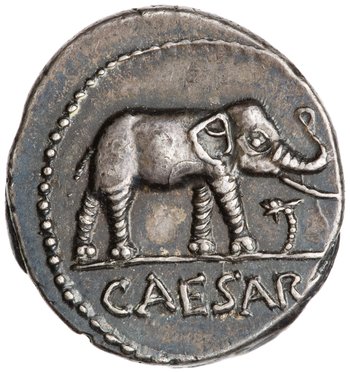 |
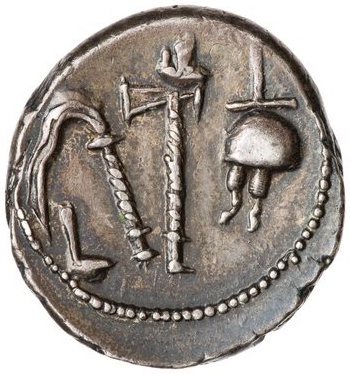 |
Silver denarius of Julius Caesar (RRC 443/1)
One of Julius Caesar's most famous coin issues is the ‘elephant denarius’. The reverse features a group of religious symbols: a culullus, aspergillum, an axe decorated with animal imagery, and an apex. On the obverse, the denarius shows a right facing elephant with the word "CAESAR" in the exergue. An estimated 22.5 million pieces were minted, making this coin the third most frequent in the Republican era and adequate to pay eight legions. It is often dated to 49 B.C, the year Caesar took large quantities of gold and silver from the treasury in the Temple of Saturn in Rome. This metal was probably used to fund his new denarius. The date is one among the questions about the coin that continue to be debated. Other undecided issues include what the elephant is standing on.
The elephant may symbolize Caesar's Gallic campaign against Ariovistus in the battle of Vosges in 58 BC, especially if the object on which the elephant treads is a Gallic war trumpet. But this object could arguably be a snake, meaning that the coin communicates the victory of good over evil. Among other propagandizing purposes, it could have been intended to humiliate the self-important and supercilious Pompey, who had tried to associate himself with Alexander by riding a symbol associated with Alexander the Great, the elephant, in his triumphal procession. Pompey had, embarrassingly, failed to actually manoeuvre the animal into the city. The image might represent the snake as a natural enemy of the elephant.
The religious symbols associate Caesar with his prestigious pontifical position as the head of Rome's religious hierarchy. Caesar had been Pontifex Maximus since 63 B.C. The symbols are similar to the augural ones that are more common on Republican Roman coins, including the lituus. Because Caesar did not become an augur until 47 B.C, and since the coin is dated to, at the earliest, the 50s, or more likely 49, it should be noted the symbols here are not augural.
However the view of some scholars suggest that the imagery of the elephant suggests that Julius Caesar considered himself on the same footing as famous military generals such as Alexander the Great and Hannibal.
 |
This month's coin was written by Alfred Wrigley. Alfred is a 2nd Year Ancient History and Classical Archaeology student with great interest in Julio-Claudian Numismatics and is hoping to specialise in numismatics of Julius Caesar.
Coin image reproduced courtesy of the American Numismatic Society.
May 01, 2015
In the shadow of a dictator
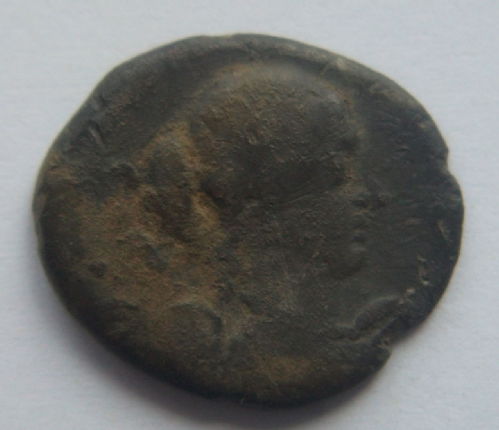 |
 |
Coin of Titus Carisius
Obverse: Victoria right, SC behind. Reverse: Victory driving a Quadriga, T.CARISI in exergue (Sydenham 985, Crawford 464/5)
If one were to poll 100 individuals about the name ‘Titus Carisius’, all 100 would be forgiven for having never heard of him. His appearance in the Roman Republican monetary record is simply overshadowed by the folklore popularity of contemporary figures such as Pompey the Great and Julius Caesar. Even Roman historians only briefly record the exploits of the gens Carisia, the lineage from which Titus descends. Cassius Dio refers to a ‘Titus Carisius’, presumably the same individual as our moneyer, defeating the native Astures in the province of Hispania and founding a colonia there (Dio LIII.25.8). However, the later historian Florus records the same feat of 25BC as the exploits of a legate with the praenomen ‘Publius’ not ‘Titus’ (Epitome II.33; Florus lived from c. 70 – 140 AD). It would appear from the subsequent coinage of the new colonia founded for the Legio V Alaudae and Legio X Gemina that Florus was correct in his documentation as coin legends clearly record P. CARISI as the legate and pro-praetor. Such confusion therefore compounds the disappearance of Titus Carisius from history. This article seeks to re-establish this forgotten triumvir monetalis of 46 BC alongside the recognizable names of the period, by evaluating one example from the fascinating series of coins he produced.
The actual coin used in this article is a recent discovery from Britain that has inspired this piece. At first glance it would appear to most as an ordinary example of Republican coinage, displaying the personification of a goddess on the obverse with a symbol of Republican Rome on the reverse. In this case it depicts a quadriga (4-horse chariot); a symbol used on the earliest denarii of 211 BC. This traditional symbol twinned with a goddess here would not look out of place amongst those late 3rd century BC issues, were it not for the goddess depicted on our coin. The personification of Victoria with the legend S.C adorns the coin’s obverse, a symbolization therefore of a victory commemoration.
History does not record a triumph of the gens Carisia in 46 BC when this coin was struck, nor is there a documented history of the Carisian line before the mid 1st century BC. So it is unlikely this coin issue commemorates a family victory. It must therefore herald the victory of a contemporary event or figure - Julius Caesar. Such a conclusion should not be remarkable, considering Caesar had just been declared a dictator for ten years. He was therefore well-known, holding a position of direct and indirect influence over the coinage minted. Another known type of Titus Carisius depicts a cornucopia above a globe with a sceptre and rudder on either side (Crawford 464/3A). Such imagery evokes ideas of wealth and prosperity over the globe, with the rudder acting as a guide. This is comparable with Caesar’s accomplishments in annexing Gaul and forays to Britain in the previous decade.
Furthermore, connections between the quadriga-issue and a Caesarian triumph can be identified when Caesar’s own coin types are considered. It is widely accepted that Caesar continued his own coin production from his moving Spanish mint in 46 BC, striking types that reference his victory in the bello gallico of 58-50 BC (See RSC 13; Sydenham 1014; Crawford 468/1). Further links between the two can be found from an inscription (Figure 1) discovered in Avignon in 1841 believed to date from the third quarter of the 1st century BC (see Christol, M: Une nouvelle dédicace de T(itus) Carisius, praetor Volcarum, près d'Ugernum (Beaucaire, Gard) 2005 for more information). It briefly records a “Titus Carisius, son of Titus, Praetor of the Volcarum”, leading to speculation that Titus may have been the son of a soldier of the Volques tribe of Southern Gaul, granted Roman citizenship during Caesar’s time. This offers a potential explanation for a lack of records for a gens Carisia prior to the 1st century BC and even circumstantial evidence of historical connections between a character likely to be our moneyer and Caesar. Therefore it is by no means a stretch of the imagination to compare their coinages.

Figure 1: Avignon Inscription (Wikimedia Commons)
The reverse of our coin has similar Republican-themed imagery, with an unmistakable figure driving a quadriga with T.CARISI beneath in the exergue. Once more the personification of Victory appears, again suggesting that this coin’s message of victory is too forceful to be unintentional – hinting at the fusion of existing Republican iconography with contemporary Caesarian ideology. On reflection, this may provide the ultimate reason why ‘Titus Carisius’ has been virtually erased from history. The fact this coin type is so similar to many other Republican issues, as well as being loaded with Caesarian propaganda, aided Carisius’ disappearance. However one factor remains that explains how I am able to write such an article upon Carisius’ coinage - his name. The very fact that Titus Carisius ascribed his own coinage, a standard practice among Republican moneyers, gives us a small window into the dying days of the Republic, a time clearly dominated by the actions of one man and his heirs. Yet this coin offers more; it provides insight into the actions and presumably the aspirations of other forgotten members of the ruling classes. Does this coin, however subtly clouded in Caesarian propaganda, radiate a hope for the restoration of earlier Republican values by utilizing an established coin design, or does it simply confirm the acceptance of a dictator? However likely the latter is from the available evidence, the true meanings of the coin have unfortunately been lost to the passage of time. I am however certain of one thing… I’m glad he left us his name.
 Written by Gregory Edmund, currently a 2nd Year Undergraduate studying Ancient History at the University of Warwick. His main interests lie in Republican Roman coinage (after 211BC) as well as Iron-Age and Roman Britain.
Written by Gregory Edmund, currently a 2nd Year Undergraduate studying Ancient History at the University of Warwick. His main interests lie in Republican Roman coinage (after 211BC) as well as Iron-Age and Roman Britain.
April 01, 2015
The coin that killed Caesar?
It is the 15th of March 44 BC, and as Julius Caesar sets forth from the threshold of his house to commence his journey to the Theatre of Pompey to convene with the Senate, he has no idea that he will not return later this day. Never would he have imagined that his life would come to such a brutal and bloody end at the hands of those he deemed so close to him. Indeed, as Plutarch informs us, the man was stabbed a total of 23 times by various senators, all so incredibly eager to partake in this momentous event in history that “many of the conspirators were wounded by one another, as they struggled to plant all those blows in one body” (Plutarch, Caesar, 66). To say that Caesar’s assassination was a veritable bloodbath would be a mere understatement. Well, what if I were to tell you that one of history’s most infamous murders could have been motivated by a single coin?
 |
|
Denarius with portrait of Julius Caesar on the obverse (RRC 480/3)
|
In the very same year of Caesar’s assassination the moneyer P Sepullius Macer minted a silver Roman denarius with a portrait of Caesar on the obverse. Such a tradition was not new to the ancient world as demonstrated by earlier coins depicting the visage of Alexander the Great, however, there can be no doubt that this custom was new to Rome. And this is incredibly important because in doing so not only did he break with an important tradition, but more to the point, he dangerously associated himself with the trappings of a king. To the majority of us living in the modern world the concept of kingship is widely accepted but it is crucial to stress that for the Romans the term ‘king’ had acquired a seriously negative connotation by this point. In many ways, to associate one’s self with the trappings of a king was political suicide because of Rome’s inherent fear of too much power landing in the lap of one individual.
On the obverse of the coin the legend states “CAESAR DICT PERPETVO” meaning “Caesar, dictator for life” clearly suggesting that Caesar had arrived at a position of unrivalled power in which he undisputedly exerted a huge amount of control over Rome. Furthermore, the reverse of the coin depicting Venus holding Victory in her palm advocates an obvious message that Caesar is the man responsible for Roman peace and prosperity; he is of a higher status than any of his political rivals; he is the pinnacle of Roman greatness. One can’t help but wonder if this representation may have brought to mind for the political elite a concern that history might repeat itself culminating in the rebirth of another cruel King Tarquin.
It would also be worth considering that through the medium of coinage Caesar’s face would quite literally have been ‘in the face’ of his political enemies each and every day. Although the majority of Romans were illiterate and therefore unable to read the legend on the coin, they would still be affected by Caesar’s ‘propaganda’ because they could interpret the images and symbols. It is also worth remembering that there were numerous other suggestions of kingship including the curule chair that Caesar sat on in the senate, the fact that he was always allowed to state his opinion first, and that he gave the signal for the games to begin in the Circus.
On the other hand, it is important to consider the argument that the coin’s portrayal of Caesar was neither kingly nor divine and therefore it can be disregarded as a motivation for his assassination 44 BC. For instance, why would Brutus have followed in Caesar’s footsteps and placed his own portrait on the EID MAR coin (as seen below) in the following year if it was seen as unacceptable in the eyes of the Romans? If one of Brutus’ motivations to murder Caesar was that Julius Caesar was becoming more and more like a king then why would he, after killing him for that very reason, have portrayed himself in a kingly manner also? Moreover, Caesar’s veiled head on the obverse seemingly shows that he is supplicating the gods and therefore he is disassociating himself from the divine to show that he is mortal. This is further highlighted by the representation of his facial features like his sunken cheeks and pronounced Adam’s apple, which, in contrast to the eternally youthful appearance of gods, clearly show that he is human.
 |
| Denarius of Brutus with his portrait on the obverse (RRC 508/3) |
Although the coin of Macer was clearly not the sole factor responsible for Julius Caesar’s famous demise, one can be sure that what it symbolises and represents must have played a pivotal role. In this respect, it seems only just to finish by saying that this object should be seen much more than simply a coin. It is an invaluable historical artefact that tells the story of how one man’s ambitions drove Brutus and Cassius along with the rest of the conspirators to take action and inadvertently set in motion a series of events that were to plunge the Roman Republic into more than a decade of civil war from which it would re-emerge as the Roman Empire.

This month's coin was chosen by George Heath. George is a first year undergraduate studying Classical Civilisation. He enjoys coin collecting and has a particular interest in early Republican coinage. He is also interested in the period surrounding Octavian's rise to power and the Augustan principate.
Images © The Trustees of the British Museum
October 30, 2013
Intended or Accidental? Questions surrounding Crawford 480/20
 |
| Crawford 480/20 |
Sometimes in numismatics one needs to go beyond what is listed in a coin catalogue to discover more about the intentions or audience of a particular coin.This was the case this morning when working on a coin series struck just after Julius Caesar's assassination in 44BC, struck by the moneyer P. Sepullius Macer. Three coin issues were released by Macer showing a desultor, or person who leapt from one horse to another; the coins were probably struck in connection a festival held in this year, perhaps the Parilia.
Struck immediately after Caesar's assassination, this particular series has been seen as important evidence of the use of Caesar's memory by Mark Antony. The first in the series (Crawford 480/20, shown right) shows a laureate, veiled head of Julius Caesar, with the legend CAESAR PARENS PATRIAE. The desultor type is then combined with an obverse showing the planned temple to Caesar and his clemency (Crawford 480/21), and finally an obverse showing Mark Antony, veiled and sporting a beard as a sign of mourning (Crawford 480/22).
 |
| Crawford 480/22 |
The traditional interpretation of the coins is that it demonstrates Antony's alignment with the murdered Caesar, since Julius Caesar is initially shown veiled on the coin series, only to be substituted by the veiled Mark Antony. But in trying to find examples of the coin showing the veiled head of Julius Caesar (Crawford 480/20), I soon discovered that there is only one specimen in Paris, and none of the other major numismatic collections (ANS, British Museum), appear to have a specimen of this particular coin. The specimen in Paris, and illustrated by Crawford in his plates, may be the only example known. Given this, one is forced to wonder whether the coin was in fact a mistake or minting error: an accidental combination of the obverse die showing Julius Caesar from one of Macer's other coin issues (e.g. Crawford 480/19), with the new reverse commemorating the games of the Parilia. If it was a mistake perhaps only a few coins were struck before the error was realised, and the desultor type was combined with its 'intended' obverses. If the theory is correct, we should change how we view this particular issue, and the desultor series more generally.
If anyone does know of other examples of Crawford 480/20, I would be grateful for any information!!
(Coin above reproduced courtesy of Classical Numismatic Group Inc., (Auction 190, lot 1395) (www.cngcoins.com)
September 01, 2013
A Roman denarius and Renaissance medallion showing a pileus and daggers
(Coin of the Month March 2013)
This famous silver denarius celebrates the murder of Julius Caesar in 44 BC. 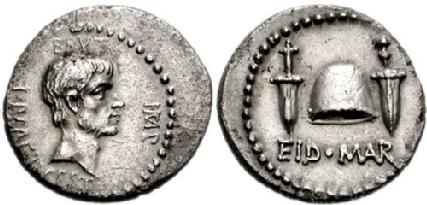 It was minted by Marcus Iunius Brutus in northern Greece during the late summer of 42 BC, for he had fled Rome after the assassination. Soon after, at the second Battle of Philippi, Brutus and his fellow conspirators were defeated by Mark Antony and Octavian, and he committed suicide. The obverse of the coin presents a bareheaded Brutus, with the legend “Brutus, Imperator, Lucius Plaetorius Cestianus (moneyer).” Republican coins did not display portraits of living men, but on this denarius Brutus included his own effigy and his title of Imperator, more in line with the coins of Julius Caesar, the man he had killed for supposedly wanting to be king. The reverse shows the cap of liberty (pileus), which was traditionally given to slaves on manumission, between two daggers. The chilling legend underneath reads EID(ibus) MAR(tiis)(Ides of March). Therefore, on one side of the coin Brutus claims to have liberated the fatherland and saved the Republic, but on the other side he presents himself as a general in the style of Julius Caesar. A few years later, Octavian (Augustus) would succeed in using both kinds of self-advertisement to create the Principate, marking the end of the Republic and the beginning of the Roman Empire.
It was minted by Marcus Iunius Brutus in northern Greece during the late summer of 42 BC, for he had fled Rome after the assassination. Soon after, at the second Battle of Philippi, Brutus and his fellow conspirators were defeated by Mark Antony and Octavian, and he committed suicide. The obverse of the coin presents a bareheaded Brutus, with the legend “Brutus, Imperator, Lucius Plaetorius Cestianus (moneyer).” Republican coins did not display portraits of living men, but on this denarius Brutus included his own effigy and his title of Imperator, more in line with the coins of Julius Caesar, the man he had killed for supposedly wanting to be king. The reverse shows the cap of liberty (pileus), which was traditionally given to slaves on manumission, between two daggers. The chilling legend underneath reads EID(ibus) MAR(tiis)(Ides of March). Therefore, on one side of the coin Brutus claims to have liberated the fatherland and saved the Republic, but on the other side he presents himself as a general in the style of Julius Caesar. A few years later, Octavian (Augustus) would succeed in using both kinds of self-advertisement to create the Principate, marking the end of the Republic and the beginning of the Roman Empire.
The coin was imitated in Renaissance Italy. On 6 January 1537, the first Duke of 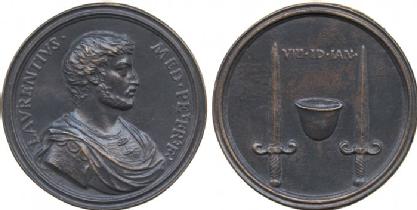 Florence, Alessandro de Medici, was murdered by his cousin Lorenzo di Pierfrancesco (Lorenzino or Lorenzaccio). Although the ultimate motives of Lorenzino are a subject of debate, his attempt to identify with Brutus and the model of classical tyrannicide is clear. In his Apologia he claims to have rid Florence of a tyrant. Also, Lorenzino followed the design of the Brutus denarius in his bronze medal, but in this case the daggers and pileus are inverted. He is even depicted wearing Roman dress and the date of the murder is VIII.ID.IAN, or eight days before the Ides of January.
Florence, Alessandro de Medici, was murdered by his cousin Lorenzo di Pierfrancesco (Lorenzino or Lorenzaccio). Although the ultimate motives of Lorenzino are a subject of debate, his attempt to identify with Brutus and the model of classical tyrannicide is clear. In his Apologia he claims to have rid Florence of a tyrant. Also, Lorenzino followed the design of the Brutus denarius in his bronze medal, but in this case the daggers and pileus are inverted. He is even depicted wearing Roman dress and the date of the murder is VIII.ID.IAN, or eight days before the Ides of January.
The French Revolution also expressed interest in Brutus and his coin. In March 1792, an article on the bonnet rouge mentions an extremely rare piece, ‘une superbe medaille d’or … antique et d’un beau travail,’ representing Brutus on one side and a bonnet between two daggers on the other side. The author proudly notes that the red bonnet of the revolutionaries is similar to the pileus in shape and in meaning: “this woollen bonnet was, in Greece and Rome, the emblem of freedom from slavery, and the rallying sign for all enemies of despotism” [Révolutions de Paris, no.141]. Finally, along with other classically-inspired symbols, the bonnet rouge made its way to America, and it can be found in the coats of arms of many countries today.
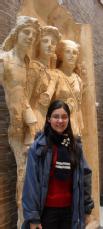 This month’s coin was chosen by Desiree Arbo, a first year PhD student. Desiree’s research focuses on the reception of Rome in 19th century Paraguay (South America). She is interested in the way elite thinkers used classical imagery and the idea of Rome in constructing the Paraguayan nation.
This month’s coin was chosen by Desiree Arbo, a first year PhD student. Desiree’s research focuses on the reception of Rome in 19th century Paraguay (South America). She is interested in the way elite thinkers used classical imagery and the idea of Rome in constructing the Paraguayan nation.
(Coin images above reproduced courtesy of Classical Numismatic Group Inc., (www.cngcoins.com) and Baldwin's Auctions Ltd [Auction 64, lot527])
Denarius showing the temple of Divus Julius, 36 BC (RRC 540/2)
(Coin of the Month, December 2012)
This denarius was struck in 36 BC, 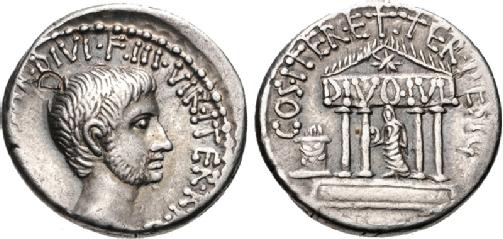 and depicts a mournful Octavian on the obverse, and the unfinished temple of Divus Julius on the reverse, and is a great example of the propaganda-tactics Augustus employed to get into a position of such power. This coin is a homage to Augustus’ relationship with the late Julius Caesar, and a display of his divine heritage. The obverse shows a young Augustus – the youthful image that would remain of him past his death, a contrast to previous realistic and less flattering portraits. He is shown here as bearded, which tells us that he is still in mourning, though his adoptive father died eight years previously in 44 BC. The legend reads ‘Imperator Caesar, Son of the Deified, Triumvir for the establishment of the Commonwealth for a second time’, and here the DIVI F (Son of the Deified) is emphatic above his head, and links very well to the reverse. The reverse shows the temple of the Divine Julius, which though begun in 42 BC (upon the spot of Caesar’s cremation), was not inaugurated until 29 BC. The legend ‘Divine Julius’ upon the temple is bold and eye catching.
and depicts a mournful Octavian on the obverse, and the unfinished temple of Divus Julius on the reverse, and is a great example of the propaganda-tactics Augustus employed to get into a position of such power. This coin is a homage to Augustus’ relationship with the late Julius Caesar, and a display of his divine heritage. The obverse shows a young Augustus – the youthful image that would remain of him past his death, a contrast to previous realistic and less flattering portraits. He is shown here as bearded, which tells us that he is still in mourning, though his adoptive father died eight years previously in 44 BC. The legend reads ‘Imperator Caesar, Son of the Deified, Triumvir for the establishment of the Commonwealth for a second time’, and here the DIVI F (Son of the Deified) is emphatic above his head, and links very well to the reverse. The reverse shows the temple of the Divine Julius, which though begun in 42 BC (upon the spot of Caesar’s cremation), was not inaugurated until 29 BC. The legend ‘Divine Julius’ upon the temple is bold and eye catching.
This emphasis shows just how eager Augustus was to forge a link between himself and his divine heritage through the promise of a temple. The veiled figure is holding an augur’s staff, and must be a statue of Julius Caesar.The star on the pediment has specific significance; it is the special sidus Iulium, and is yet another sign of Augustus’ divine parentage. A short few months after the infamous death of Julius Caesar, Octavian hosted the Ludi Victoriae Caesaris, which was a daring political move in his rivalry against Mark Antony. The Games were held from 20th – 28th July 44 BC, alongside a festival to honour Venus Genetrix, Caesar’s patron deity, and are famous for the star of Caesar incarnate. Octavian claimed that the comet was the deified Julius Caesar, and this was proof that he was indeed the son of a god. Suetonius tells us that the comet shone for seven successive days, and that everyone believed it was the soul of Caesar after Octavian had shouted out. Octavian wasted little time, and used this imagery of the star on coins and every statue of Caesar as a reminder of his divine right to rule. The star appears in much literature too, including Virgil’s ninth Eclogue, and the entire transformation is detailed in Ovid Metamorphoses book fifteen.

This month’s coin was chosen by Laura Christofis, a final year Classics undergraduate. Her dissertation focuses on the place of invective poems in Catullus, looking in particular at sexual and political poems.
(Coin image above reproduced courtesy of Classical Numismatic Group, www.cngcoins.com).
August 12, 2013
Caesar's elephant and Usekerte–Osicerda
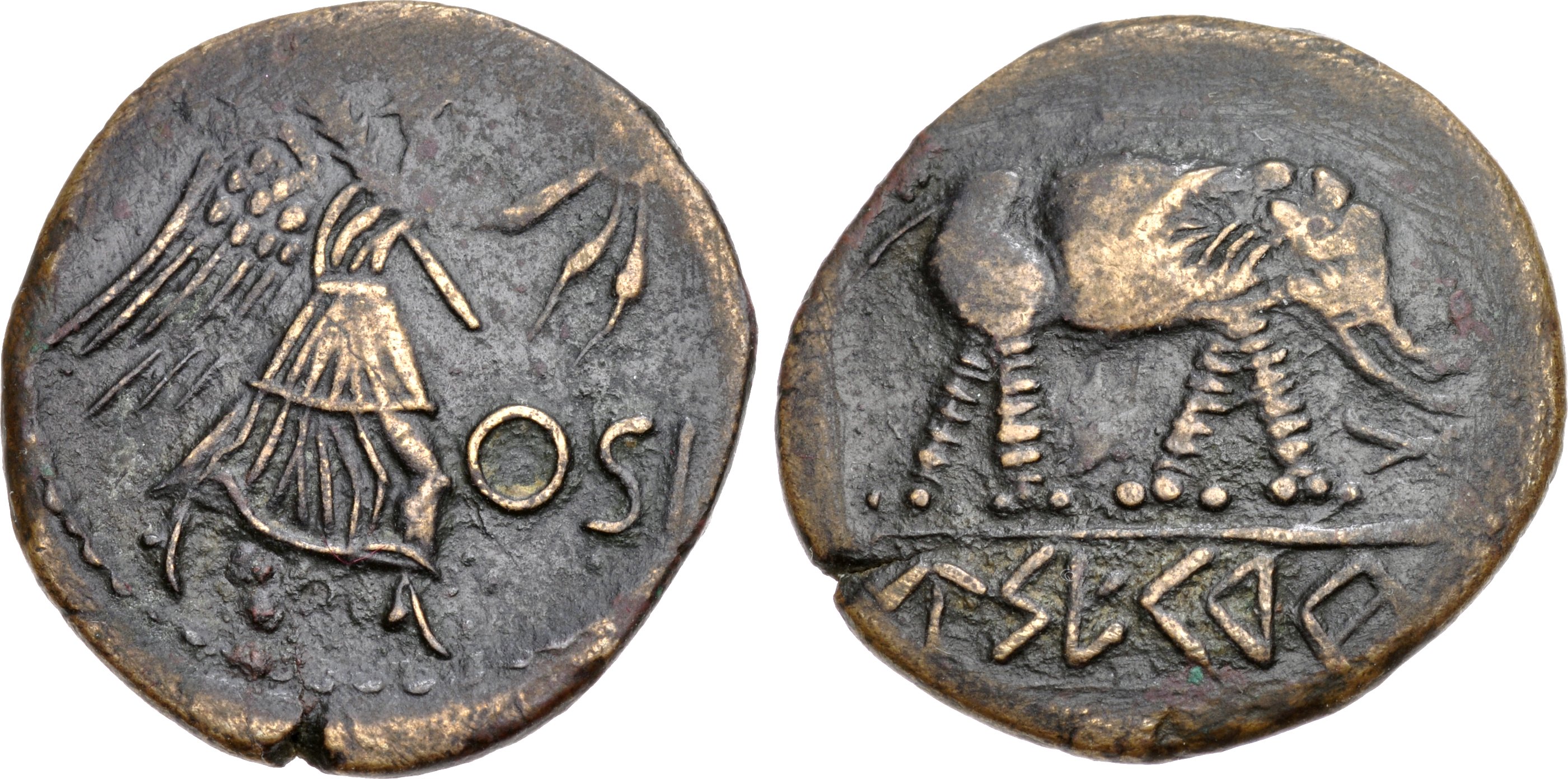 |
| Coin of Osicerda imitating a coin of Caesar |
Several coins in focus have examined the reception of Julius Caesar's imagery, the elephant and 'snake' coin he struck in 49 BC. A further example of the reception of this imagery is a bi-lingual coin issue struck by Usekerte-Osicerda in Spain (Villaronga and Benages 1292-3). The obverse of the coin imitates a quinarius struck in Rome in 47 BC. It shows Victory, accompanied by the Latin legend OSI, a reference to the issuing authority. As with many Iberian coins in this period, this issue is bilingual, naming the tribe or city in both Latin and Iberian (or another local language). The reverse imitates Caesar's coin type of an elephant trampling a 'snake' (exactly what the creature/object is remains the subject of debate), with the Iberian legend Usekerte in the exergue. The question is: why would Iberians imitate Caesar's coin in this manner?
One suggestion is that the coin was struck to celebrate a victory of Caesar in the region, perhaps Caesar's victory over Lucius Afranius and Marcus Petreius at the battle of Ilerda in 49 BC, or his success at the battle of Munda in 45 BC (M.G. Justo, 1996-7. Las acuñaciones de Usekerte/Osicerda. Annals de l'Institut d'Estudis Gironins, 36, 321-33). The mint of this piece may have been located close to where the battle of Ilerda took place, and so this seems a possible scenario. If this is the case the coin series must have been commemorative: the obverse, after all, imitates a coin of 47 BC, several years after Ilerda.
What this piece demonstrates is that the iconography used by Caesar and the Romans more broadly was seen and understood by Iberians, who could then appropiate the imagery to make their own statements of allegiance and support. The coin communicates Isekerte-Osicerda's support of Caesar during the civil wars - the elephant is a reference to Caesar and his coinage, while another Roman coin type, Victory, was appropriated to celebrate the success of Caesar in the region. Coin hoards suggest that Caesar's elephant type circulated in the region in quantity - the imagery would thus have been 'seen' as it moved from hand to hand. But instead of the legend CAESAR, this coin series has an Iberian legend, one of the last struck that carry the Iberian script.
(Coin image reproduced courtesy of Image reproduced courtesy of Classical Numismatic Group Inc., (Auction 91, lot 26) (www.cngcoins.com)).
 Clare Rowan
Clare Rowan

 Please wait - comments are loading
Please wait - comments are loading

 Loading…
Loading…

